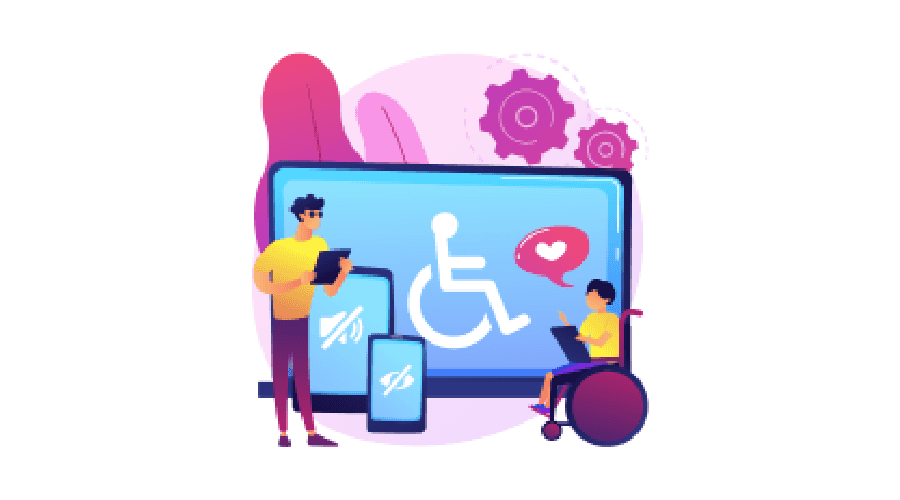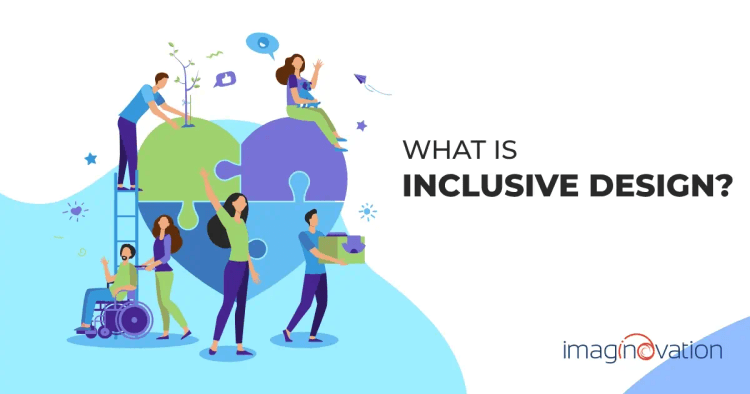In a rapidly evolving world that celebrates the uniqueness of every individual, the concept of design has transcended traditional boundaries.
Welcome to a world where 'exclusive' is out of fashion and 'inclusive' is the new cool!
In today's digital age, where everyone is just a few clicks away, it's high time we embrace the power of ‘Inclusive design”, a design approach that doesn't play favorites.
Join us on this captivating blog as we decode what inclusive design is all about and uncover why it holds more significance now than ever before.
Get ready to say goodbye to digital walls and hello to a connected world where everyone's invited to the party!
Let’s read on and discover how to design a digital landscape that's as diverse as our world.
What is Inclusive Design?
Let me ask you a few questions:
- Do you wear glasses or contact lenses and struggle to read small text on a website or mobile app?
- Do you prefer to use captions while watching a video?
- Have you ever used voice commands to interact with a digital assistant or device?
- Have you ever felt excluded or frustrated while using a product or service?
If you answered "yes" to any of these questions, then you have experienced the importance of inclusive design.
But what is inclusive design?
Inclusive design is a design principle that aims to create digital services, apps, and diverse products that can be used by the broadest section of the audience, regardless of age, physical ability, cognitive ability, situational impairment, gender, race, or cultural background.
Inclusive design is all about making sure that everyone feels welcomed and included.
So, the next time you use a product or service without any barriers or challenges, know that a lot of thought and effort went into designing it inclusively.
In essence, inclusive design is a deliberate attempt to include the needs of users who often face exclusion due to being part of marginalized or statistically minority sections within society.
Remember, if you fail to include, you run the risk of inadvertently excluding.
Besides, embracing inclusive design offers advantages to both customers and businesses alike. It broadens the reach of your product, promotes innovation, and positions your company as a socially responsible entity.
The Principles of Inclusive Design
Here are the five key principles for adopting inclusivity in your design practice:
1. Uncover your own biases
Work towards eliminating biases and assumptions by embracing diverse perspectives, questioning, and truly understanding your users.
2. Identify various situational hurdles
Sometimes, exclusion arises situationally. Think about how users use your product and ensure it works well in everyday situations where they might feel left out. For example, a navigation app giving audio directions may pose situational hurdles in a noisy area.
3. Follow a holistic approach
Commit to inclusive design fully; don't just use it for initial attraction, but integrate it holistically into the entire product development journey from start to finish.
4. Identify areas of exclusion
Proactively look for areas where people are left out and use them to generate fresh ideas to create new solutions. By understanding how and why people are excluded, we can take concrete actions to become more inclusive.
5. Make the solution accessible to all
Creating a solution for a specific user group can benefit many others or a wider range of people. For example, a larger font size feature, intended for those with visual impairments, can also be useful for someone who is driving a car.
Examples of inclusive design in action.
- Closed Captions in Videos: Adding closed captions to videos not only helps individuals with hearing impairments but also benefits viewers in noisy environments or those watching without sound, such as in quiet spaces.
- Voice Commands in Smart Devices: Integrating voice commands in smart devices not only assists people with mobility challenges but also offers a convenient hands-free experience for anyone, such as when cooking or multitasking.
- Multilingual Interfaces: Offering interfaces in multiple languages ensures accessibility for non-native speakers and opens products and services to a global audience.
Why Inclusive Design Matters?
Using many different ways that people interact with various apps and designs costs more and is less efficient.
It also divides users based on their strengths, weaknesses, abilities, and disabilities. Instead, making a design that anyone can use, no matter their skills, brings everyone together.
In a world that thrives on diversity and individuality, design holds the power to bridge gaps, amplify voices, and dismantle barriers.
Here’s why inclusive design matters for both businesses and customers.
1. Widest possible market expansion
When apps and services are created with accessibility in mind, they can be used by more people. More people using them means a broad market reach, more potential customers, and more revenue.
So, businesses that care about making a profit should understand why inclusive design is important.
Inclusive design goes the extra mile to ensure that your products and services are easy to use and accessible to a much wider group of people.
Accessible apps help people with different needs, like those who can't see, hear, or have mobility issues. Or people who have specific needs that might not have been considered in the past.
By making product designs inclusive and accessible, you can connect with customers you might not reach otherwise or who might have felt left out when more conventional designs were the norm.
2. Equitable access for all

In the world of software and digital services, ensuring equitable accessibility is a fundamental responsibility for organizations.
The designs of these apps, websites, and other products must be inclusive and accessible to everyone.
This commitment goes beyond just doing what's right; it's about avoiding any potential discrimination against people with disabilities, which could have legal or professional consequences.
The COVID-19 pandemic accelerated the growth of the digital world, providing solutions for remote work, learning, healthcare, and more. However, this rapid expansion created challenges for individuals who couldn’t access products due to various challenges.
Inclusively designed platforms offer the best possible solution here.
Equitable accessibility is not a feature you can overlook; it must be a top priority.
3. Boost in reputation building
When a business demonstrates a commitment to inclusive design by building products and services that are accessible to everyone, including people with disabilities, it sends a positive message to customers and the public at large.
This commitment to inclusivity can enhance the company's reputation as socially responsible, caring, and considerate.
Customers today often value companies that prioritize diversity, equity, and inclusion.
By showing that they are actively working to make their offerings accessible to a wider range of individuals, companies can foster goodwill, build trust, and attract a more loyal customer base.
This positive reputation can lead to increased customer loyalty, positive word-of-mouth recommendations, and even media recognition, all of which can contribute to the company's overall success.
4. Long-term cost savings
Adopting inclusive design can actually lead to some pretty smart cost savings for businesses.
At first, you might think it's an extra expense to design and develop products with accessibility in mind, but it's a bit like planting seeds that grow into valuable benefits over time.
How?
By tackling accessibility issues right from the start, during those early design and development phases, you can avoid the headache of having to go back and make costly changes down the line.
Redesigning products to make them accessible can be a real drain on resources, both time-wise and financially. So, inclusive design is like building your project on a solid foundation, saving you those later renovations.
Moreover, embracing inclusive design gives you a shield against potential legal troubles. Inaccessible products can sometimes land you in trouble with regulations and legal requirements. By ensuring your products are accessible, you're sidestepping those risks and potential fines.
Another thing: designing with inclusivity in mind doesn't just open doors for people with different needs; it also opens doors for your business. More accessible products mean more potential customers and increased sales and revenue.
The initial investment in accessibility pays off soon.
5. Enhanced innovation

When you intentionally design with inclusivity in mind, you do not just create products that work for everyone; you also dive into a world of fresh ideas.
So, diverse perspectives and needs can act as a catalyst for creative thinking.
Imagine a puzzle where each piece is different – that's what inclusivity brings to the design table.
When you consider how people with various abilities will engage with your creations, you're pushed to craft solutions that are not only effective but often groundbreaking. Inclusive designing does just that.
Challenges of Implementing Inclusive Design
Implementing inclusive design can be incredibly rewarding, but it comes with its share of challenges that organizations must address. Some common challenges include:
1. Lack of Education and Awareness
Many designers and developers may be unaware of the importance of inclusive design or the specific needs of different user groups.
One of the main challenges is ensuring that designers have the necessary knowledge and understanding of inclusive design principles.
A lack of knowledge and understanding about inclusive design principles can hinder successful implementation.
2. Shifting Mindsets
Embracing inclusive design requires a fundamental change in how designers, developers, and other stakeholders think about their products and users.
Overcoming traditional design practices and biases is a significant challenge many businesses face.
Designers and stakeholders sometimes need to challenge traditional norms, resistance to change, and overcome preconceived notions to fully embrace inclusive design.
3. Balancing Features
While inclusive design aims to create products that cater to a wide range of users with varying needs, finding the right balance between features that address accessibility and those that maintain a streamlined user experience can be complex.
Including a variety of features to accommodate different needs can lead to increased complexity, potentially overwhelming users and making the product harder to use.
Besides, overloading a product with various features might lead to confusion.
4. Diverse User Representation
Accurately representing and incorporating diverse user perspectives can indeed be challenging.
Involving users from different backgrounds and abilities during the design process is absolutely vital to truly understand their unique needs.
However, some user groups, particularly those with less visibility, might not have their needs adequately considered in the design process. This can lead to unintentional assumptions by designers.
Additionally, there might be resource constraints, as engaging with a variety of users for feedback and testing requires significant time, effort, and, in some cases, financial resources.
5. Design Trade-Offs
Design trade-offs are a challenge for implementing inclusive design because they involve making difficult decisions that balance the goal of accessibility with other design priorities, such as aesthetics or performance.
By addressing these challenges, organizations can overcome barriers and create more inclusive digital products and services that cater to the diverse needs of all users.
How to Incorporate Inclusive Design into Your Digital Projects
Incorporating inclusive design into your digital projects requires a thoughtful and systematic approach. Here's how you can do it:
1. Manage
Inclusive design must be considered in every part of making a product, from planning to creating it.
Begin with a Solid Plan: First, create a plan and strategy based on what the project needs and the resources you have. This plan helps control everything and ensures the product reaches its goals.
Improvement is Key: At this step, focus on improving the product and refining how things are done. This helps ensure that everyone can use the product without any biases.
Manage, Improve, Communicate: This step is about managing the process, enhancing the product, and promoting better communication among all those involved.
Keep all these steps in mind to initiate creating an inclusive and successful product.
2. Research

In this stage of inclusive design, your goal is to gather and analyze all the information about your project. Here's what to do:
Gathering Info: Your team should collect all the information about the project and the people who will use it.
Understanding Usage: It's essential to know how customers use the product so you can make it work for everyone.
During the exploration phase:
- Observe Closely: Observe how people use the product.
- Use Helpful Tools: Make use of tools like persona empathy maps.
- Design for All: Your design should be suitable for all types of users.
- Learn from Methods: Get insights from Design Thinking Tools and Methods.
- Find Solutions: Use Design Thinking Tools for Ideation to come up with solutions.
3. Create
In this step, use the information you've gathered to build a design and a prototype of your product or service.
Remember, the prototype might change after testing because it may result in improvements and alterations based on the results of the evaluation stage.
Ensure your design is simple and flexible to work well for all users.
4. Evaluate
Now, it's time to test and evaluate the prototype in this stage. Here's how to do it:
Set Clear Standards: Use predefined criteria to assess if the prototype meets the requirements.
Get Various Perspectives: Both experts and consumers should be part of the evaluation groups. This way, you'll get accurate feedback.
During this stage:
- Pick Evaluation Criteria: Choose the criteria you'll use to evaluate the prototype.
- Test the Product: Put the prototype to the test.
- Collect Results and Feedback: Gather the outcomes and opinions to make the concept better.
One helpful tool for evaluation is the SWOT Analysis. Use these steps to make sure your prototype is on the right track.
Create Intuitive, Inclusive Design with Imaginovation
In today's digital landscape, inclusive design is a powerful tool for intuitive and accessible products and services.
Embracing inclusivity is not just a choice but a responsibility we all share.
At Imaginovation, we embrace the responsibility of inclusivity, driving us toward a future where design seamlessly intertwines with diversity.
We believe that design should resonate with everyone, irrespective of their backgrounds and capabilities.
We craft empowering, engaging, and inspiring experiences for all abilities and needs.
Join us on this transformative journey of creating intuitive, inclusive designs that leave a lasting impact.
Contact us today to redefine design and create a world where there are no boundaries.
Let's talk.




